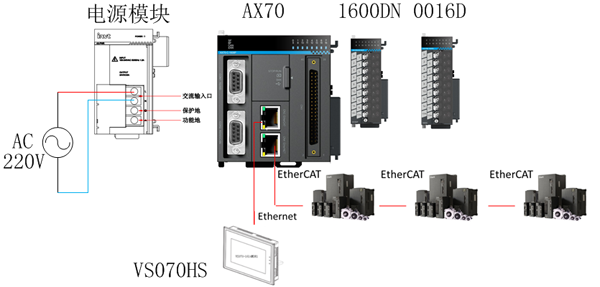1. Background
The current mainstream solution in the circuit group industry is based on pulse control, which has the disadvantages of extensive wiring, complex wiring, and poor anti-interference. The bus solution has a large technical advantage due to its easy wiring, beautiful cabling, fast data interaction speed, and good real-time status monitoring.
In the single-ended terminal insertion machine, its action axis is divided into wire pulling axis, cutter axis, panning axis, clamping axis, through the rubber shell axis, head stripping axis, tail stripping axis, swingarm axis, twisted wire axis and so on. The actions between the axes are trivial and the positional correlation is high. There are different action options according to different processes, and it is required that all processes can be realized with the highest efficiency.
2. Client requirements
A terminal insertion machine scene, the customer requires high efficiency, multi-mode witching, fast data interaction, can support the stepper drive, flexible control mode, for the equipment mainly have the following requirements:
1) Any position homing: Equipment may stop in any process step, inevitably there will be a variety of situations of positional interference. Homing function must be detached from any axis in any position under the possible positional interference, in order to avoid mechanical collision, to make sure the safety of the equipment.
2) Runs at high speeds and short strokes: When running, the panning axis has a minimum feeding of 2.5mm each time, corresponding to 0.125 revolutions of the motor, and the pressing terminal is synchronized with the panning feed, and the fastest time consumption of the pressing terminal is within 100ms, so the panning axis should be positioned within 100ms.
3) Multi-mode control: The device supports a variety of control mode selection.
4) Optimal operating efficiency: Different control modes correspond to different action requirements, and the system needs to automatically block unnecessary actions according to different modes to improve efficiency.
5) Real-time data interaction: The operating process data can be observed online to realize the self-inspection of some core processes.
6) Good compatibility: Motion controllers need to be compatible with third-party step drivers.
3. INVT solution
The system solution of AX70 motion controller+DA180 servo drive + VS070 touch screen:

Product Selection and Description | ||||
Category | Name | Model | Quantities | Description |
Motion controller | CPU module | AX70-C-1608P | 1 | Codesys controller |
Controller expansion unit | Digital input module | AX-EM-1600D | 2 | Local IO module |
Controller Expansion Unit | NPN type digital output module | AX-EM-0016DN | 2 | Local IO module |
Touch module | VK series touch screen | VK2070 | 1 | Touch screen |
Servo drive | DA180 series | DA180-S2R8NG0 | 6 | EtherCAT |
Third party product | Step driver | 4 | EtherCAT | |
Solution advantages:
1) The servo drive is equipped with a third-party stepping motor, which is convenient for customers to balance cost and performance.
2) Servo high response control to meet the requirements of high speed and short stroke control.
3) Codesys programming platform, rich in language types, convenient to meet customers' control needs and upgrades.
4) The bus servo data read/write cycle is at the ms level, which can easily realize the reading and writing of key data and complete the monitoring operation of core process data.
4. Process solution
According to the difficulties of the whole project and the realization of each process, the specific solutions of the system are:
4.1 Initialization homing
The principle of initialization is to be able to detach the positional interference between any axes and to guarantee a smooth homing.
The servo drive uses a 23-bit multi-turn encoder. During initialization, the absolute position of the servo is 0. In order to solve the position interference, the approximate homing sequence of the system is as follows:
1 | All cylinders | Reset |
2 | Delay time | 300ms |
3 | Cutter axis, panning axis, clamping axis to safe position | Zeroing |
4 | Pulling axis, head stripping axis, through the rubber shell axis, twisted wire axis | Zeroing |
5 | Head stripping axis to safe position, pulling axis | Zeroing |
Swingarm axis | Zeroing | |
Laminated shell axis | Zeroing | |
Through the rubber shell axis | Zeroing | |
6 | Tail stripping axis (Swingarm axis completed) | Zeroing |
4.2 Head stripping and termination process
The head stripping axis strips the cable and the panning spool supervisor strikes the terminals position. N wire harnesses, there are N times and N-1 spacing. The panning axis is translated to the press position, and the displacement is N-1 times according to the preset spacing, and press N times. In order to improve production efficiency, the displacement and machine are started at the same time, as long as the displacement time is less than the press time. The servo only needs 75ms for each press displacement, which fully meets the process requirements.
For easy debugging and observation, a delay time can be added before each start to observe the completion of each terminal.
The panning and press action is: “simultaneous start - successive completion - delay - simultaneous start - successive completion - delay - end”.
4.3 Multi-mode switching
Considering the diversity of customer cables and pressing terminal functions, the equipment has made a variety of mode switching, such as:
1) Tail Strip Tinning Mode.
2) Through the rubber shell mode.
3)Press terminal mode.
4)Tinning mode.
5) Twisted wire mode.
6) Fault detection mode.
7) single-step operation mode.
……
4.4 Optimal efficiency processes
The timing of actions in different modes is different, which will inevitably lead to the fact that some actions do not need to be executed, and a certain waiting time will occur in the logic, reducing the operation efficiency.
The system can automatically optimize the operation sequence according to the actual operation mode selected by the customer, skipping unnecessary waiting time and unnecessary docking positions, and greatly reducing the cycle time.
In addition, the device also supports online change control mode, the device can switch the selection function in the work project, and the system matches the current cycle or the next cycle according to the current stage to switch the mode, without stopping or homing to the original mode switch. The control efficiency is greatly improved.
4.5 Real-time data interaction
The system uses Ethercat bus for data interaction, the data read/write cycle is ms-level, and the real-time data such as position, speed, and torque of all axes are observed through the synchronization cycle, so as to complete the optimization of the core process, which greatly improves the flexibility and stability of the equipment.
5. Conclude
The terminal insertion machine has a variety of processes, trivial actions, and various modes, which require perfect control logic and flexible function selection. Based on the overall solution of INVT AX70 series motion controller on the terminal insertion machine, it not only has beautiful wiring, fast data interaction, can meet all process needs, but also can take into account the characteristics of rich control mode, flexible mode switching, extremely high operation efficiency, etc., which has strong industry promotion value.



Our site uses cookies to provide you with a better onsite experience. By continuing to browse the site you are agreeing to our use of cookies in accordance with our Cookie Policy.